Find the Best NCERT Solutions for Class 10 Science Chapter 11 on our website with all the questions and answers especially written for class 10 students. You will know about Ch 11 Electricity, learn its concepts, and get important tips 🔥 on how to write (1) precise answers (2) without using unnecessary words (3) within ideal length. You will access all of this information for FREE in addition to class 10 science NCERT solutions chapter 11.
Ch 11 – Electricity
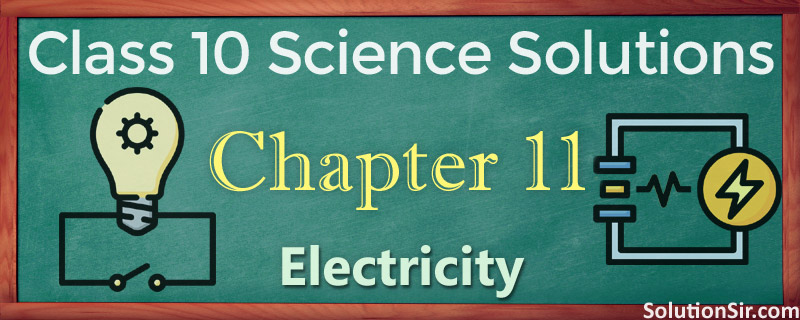
Use this link — 🌐 10.solutionsir.com for any kind of help in 10th class 2023-24. Click Here for » All Chapters: NCERT Solutions for Class 10 Science.
NCERT Solutions for Class 10 Science Chapter 11 Exercise – Electricity is a convenient form of energy that we consume on the daily basis for a variety of uses, mostly in the buildings where we live or work. But what are the factors that control or regulate the flow of electricity through a wire? ⚡ In the eleventh chapter “Electricity” (Chapter 11 Science Class 10), we shall try to answer such questions. We shall also learn about electric circuit, Ohm’s law and the heating effect of electric current.
Chapter 11 Electricity – Important Points: A stream of electrons moving through a conductor constitutes an electric current. To set the electrons in motion in an electric circuit, we use a cell or a battery. Resistance is a property that resists the flow of electrons in a conductor. Ohm’s law is used to state the relationship between electric current and potential difference. The purpose of the chapter is to teach you Electricity basics.
Special Note: 👉 Click the “Prepare” button to know, how to prepare Electricity chapter for exams. Get more helpful information, watch explanation videos and pay attention to handwritten version of our answer to score 💯 good marks in class 10 Science NCERT solutions Chapter 11. You will get everything that you need to prepare a question thoroughly.
NCERT Solutions for Class 10 Science Chapter 11
Table of Contents
Page 172
EX 1 – Chapter no 11 – Page 172 Solutions
Question 1: What does an electric circuit mean?
Answer: A continuous and closed path of an electric current is called an electric circuit.
Question 2: Define the unit of current.
Answer: The unit of electric current is ampere. If 1 coulomb of charge flows through a conductor every second then the current through the conductor is said to be 1 ampere.
Question 3: Calculate the number of electrons constituting one coulomb of charge.
Answer: Charge of 1 electron = n × e = 1.6 × 10−19 C
If n electrons make one coulomb then n = 1/e
So, n = 1/(1.6 × 10−19)
Or, n = 6.25 × 1018
Therefore, 1 coulomb of charge constitutes 6.25 × 1018 electrons.
End of Page no 172 solutions – In text exercise 1 – chapter number 11 intext questions. NCERT Solutions for Class 10 Science Chapter 11.
Page 174
EX 2 – Chapter no 11 – Page 174 Solutions
Question 1: Name a device that helps to maintain a potential difference across a conductor.
Answer: An electric battery.
Question 2: What is meant by saying that the potential difference between two points is 1 V?
Answer: The potential difference between two points is said to be 1 volt if 1 joule of work is done in moving 1 coulomb of electric charge from one point to the other.
Question 3: How much energy is given to each coulomb of charge passing through a 6 V battery?
Answer: Potential Difference = 6 V
Charge = 1 C
Now, Work done in a circuit = Potential Difference × Charge
So, energy given = 6 × 1 = 6
Therefore, 6 J of energy is given to each coulomb of charge passing through a 6 V battery.
End of Page no 174 solutions – In text exercise 2 – chapter number 11 intext questions. NCERT Solutions for Class 10 Science Chapter 11.
Page 181
EX 3 – Chapter no 11 – Page 181 Solutions
Question 1: On what factors does the resistance of a conductor depend?
Answer: The resistance of a conductor depends upon these factors –
- Length of the conductor
- Cross-sectional area of the conductor
- Material of the conductor
- Temperature of the conductor
Question 2: Will current flow more easily through a thick wire or a thin wire of the same material, when connected to the same source? Why?
Answer: Resistance (R) of a conductor is inversely proportional to its cross-section area (A). This shows that larger the area of cross-section of a conductor, more is the ease with which the electrons can move through the conductor. So, the current will flow more easily through a thick wire than a thin wire of the same material.
Question 3: Let the resistance of an electrical component remains constant while the potential difference across the two ends of the component decreases to half of its former value. What change will occur in the current through it?
Answer: According to Ohm’s law –
V = IR
Or, I = V/R
Now, the potential difference is decreased to half.
New potential difference V’ = V/2
So, the new current I’ = V’/R
Or, I’ = (V/2)/R
Or, I’ = (1/2)(V/R)
This gives us I’ = I/2
Therefore, the amount of current flowing through the electrical component is reduced by half.
Question 4: Why are coils of electric toasters and electric irons made of an alloy rather than a pure metal?
Answer: The coils of electric toasters, electric irons and other heating devices are made of an alloy rather than a pure metal because the resistivity of an alloy is much higher than that of a pure metal. Also, an alloy does not melt easily even at high temperature.
Question 5: Use the data in Table 11.2 to answer the following –
(a) Which among iron and mercury is a better conductor?
Answer: Iron is a better conductor because it has lower resistivity than mercury.
(b) Which material is the best conductor?
Answer: Silver is the best conductor because it has the lowest resistivity.
End of Page no 181 solutions – In text exercise 3 – chapter number 11 intext questions. NCERT Solutions for Class 10 Science Chapter 11.
Page 185
EX 4 – Chapter no 11 – Page 185 Solutions
Question 1: Draw a schematic diagram of a circuit consisting of a battery of three cells of 2 V each, a 5 Ω resistor, an 8 Ω resistor, and a 12 Ω resistor, and a plug key, all connected in series.
Answer: Schematic diagram of the given circuit is shown below —
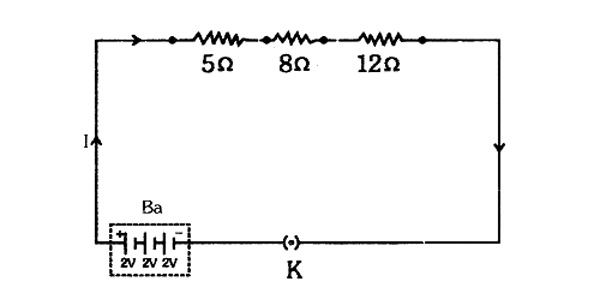
Question 2: Redraw the circuit of Question 1, putting in an ammeter to measure the current through the resistors and a voltmeter to measure the potential difference across the 12 Ω resistor. What would be the readings in the ammeter and the voltmeter?
Answer: Schematic diagram of the given circuit is shown below —
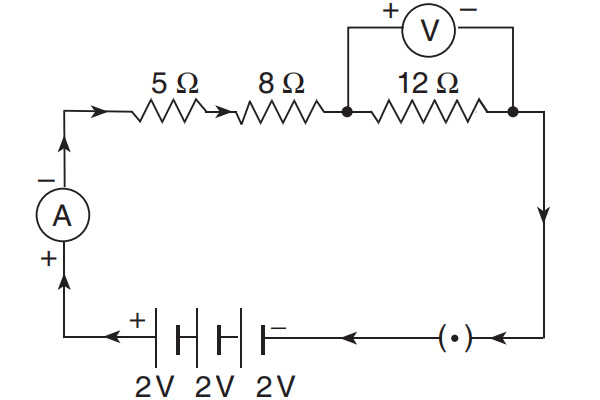
Total voltage, V = 3 × 2 = 6 V
Total resistance, R = 5 Ω + 8 Ω +12 Ω = 25 Ω
Reading of ammeter, I = V/R = 6/25 = 0.24 A
Reading of voltmeter, V = IR = 0.24 × 12 = 2.88 V
End of Page no 185 solutions – In text exercise 4 – chapter number 11 intext questions. NCERT Solutions for Class 10 Science Chapter 11.
Page 188
EX 5 – Chapter no 11 – Page 188 Solutions
Question 1: Judge the equivalent resistance when the following are connected in parallel – (a) 1 Ω and 106 Ω, (b) 1 Ω and 103 Ω, and 106 Ω.
(a) 1 Ω and 106 Ω
Answer: The net resistance in parallel is given by –
1/R = 1/R1 + 1/R2
Here, R1 = 1 Ω, and R2 = 106 Ω
So, 1/R = 1/1 + 1/106 = (106 + 1)/106
⇒ R = 106/(106 + 1) ≈ 1 Ω
Therefore, the equivalent resistance is 1 Ω.
(b) 1 Ω and 103 Ω, and 106 Ω
Answer: The net resistance in parallel is given by –
1/R = 1/R1 + 1/R2 + 1/R3
Here, R1 = 1 Ω, R2 = 103 Ω, R3 = 106 Ω
So, 1/R = 1/1 + 1/103 + 1/106 = (106 + 103 + 1)/106
⇒ R = 106/(106 + 103 + 1) = 1000000/1001001
⇒ R = 0.999 Ω
Therefore, the equivalent resistance is 0.999 Ω.
Question 2: An electric lamp of 100 Ω, a toaster of resistance 50 Ω, and a water filter of resistance 500 Ω are connected in parallel to a 220 V source. What is the resistance of an electric iron connected to the same source that takes as much current as all three appliances, and what is the current through it?
Answer: The equivalent resistance (R) of the resistors connected in parallel can be calculated by —
1/R = 1/100 + 1/50 + 1/500 = 16/500
Or, 1/R = 16/500
⇒ R = 500/16 Ω = 31.25 Ω
So the resistance of the electric iron = 31.25 Ω
Now, using Ohm’s law, the current flowing across the circuit —
I = V/R = 220/31.25
⇒ I = 7.04 A
Question 3: What are the advantages of connecting electrical devices in parallel with the battery instead of connecting them in series?
Answer: When the electrical devices are connected in parallel there is no division of voltage among the appliances. The potential difference across the devices is equal to supply voltage. The total effective resistance of the circuit can be reduced by connecting electrical appliances in parallel.
Question 4: How can three resistors of resistances 2 Ω, 3 Ω, and 6 Ω be connected to give a total resistance of (a) 4 Ω, (b) 1 Ω?
(a) 4 Ω
Answer: We can get a total resistance of 4 Ω by connecting the 2 Ω resistance in series with the parallel combination of 3 Ω and 6 Ω. So, the total resistance R can be achieved by –
R = R1 + (R2 × R3)/(R2 + R3)
Or, R = 2 + (3 × 6)/(3 + 6)
Or, R = 4 Ω
(b) 1 Ω
Answer: We can obtain a total resistance of 1 Ω by connecting resistors of 2 Ω, 3 Ω and 6 Ω in parallel –
1/R = 1/R1 + 1/R2 + 1/R3
Or, 1/R = 1/2 + 1/3 + 1/6
Or, 1/R = 6/6
⇒ R = 1 Ω
Question 5: What is (a) the highest, (b) the lowest total resistance that can be secured by combinations of four coils of resistance 4 Ω, 8 Ω, 12 Ω, 24 Ω?
Answer (a) : To get the highest resistance, we will connect the four resistances in series. Their equivalent resistance R can be achieved by —
R = 4 + 8 + 12 + 24 = 48 Ω
Answer (a) : To get the lowest resistance, we will connect the four resistances in parallel. Their equivalent resistance R can be achieved by —
1/R = 1/4 + 1/8 + 1/12 + 1/24
Or 1/R = 12/24
⇒ R = 24/12 = 2 Ω
End of Page no 188 solutions – In text exercise 5 – chapter number 11 intext questions. NCERT Solutions for Class 10 Science Chapter 11.
Page 190
EX 6 – Chapter no 11 – Page 190 Solutions
Question 1: Why does the cord of an electric heater not glow while the heating element does?
Answer: The heating element of an electric heater is made up of alloy. Alloys have very high resistance and this characteristic allows them to become hot and glow red when current flows through the heating element. But the cord of the same electric heater does not glow because it is made up of copper which has very low resistance.
Question 2: Compute the heat generated while transferring 96000 coulomb of charge in one hour through a potential difference of 50 V.
Answer: Voltage V = 50 V
Time, t = 1 h = 1 × 60 × 60 s.
Now, the amount of heat (H) produced is given by the Joule’s law of heating as —
H = VIt
Or, H = V.q/t.t
Or, H = V.q
Or, H = 50 × 96000
Or, H = 4.8 × 106 J
Therefore, the heat produced while transferring the charge is H = 4.8 × 106 J.
Question 3: An electric iron of resistance 20 Ω takes a current of 5 A. Calculate the heat developed in 30 s.
Answer: Resistance, R = 20 Ω
Current I = 5 A
Time, t = 30 s
Now, the amount of heat (H) produced is given by the joule’s law of heating as —
H = Vlt
Also, V = I × R
So, H = (I × R)It
H = (5 × 20) 5 × 30
H = 1.5 × 104 J
Therefore, the amount of heat developed in the electric iron is 1.5 × 104 J.
End of Page no 190 solutions – In text exercise 6 – chapter number 11 intext questions. NCERT Solutions for Class 10 Science Chapter 11.
Page 192
EX 7 – Chapter no 11 – Page 192 Solutions
Question 1: What determines the rate at which energy is delivered by a current?
Answer: The rate of consumption of electric energy in an electric appliance is known as electric power. Hence, the power of the appliance determines the rate at which energy is delivered by a current.
Question 2: An electric motor takes 5 A from a 220 V line. Determine the power of the motor and the energy consumed in 2 h.
Answer: Power of the electric motor, P = VI
Substituting the values, P = 220 × 5 = 1100 W
The energy consumed by the motor, E = Power × time
So, E = 1100 × 7200 = 7920000 J
Therefore, the power of the motor is 1100 W and the energy consumed by the motor in 2 hours is 7.92 × 106 J.
End of Page no 192 solutions – In text exercise 7 – chapter number 11 intext questions. NCERT Solutions for Class 10 Science Chapter 11.
Page 193
Chapter End Exercises – Page 193 Solutions
Question 1: A piece of wire of resistance R is cut into five equal parts. These parts are then connected in parallel. If the equivalent resistance of this combination is R’, then the ratio R/R’ is –
Answer: (d) 25
Question 2: Which of the following terms does not represent electrical power in a circuit?
Answer: (b) IR2
Question 3: An electric bulb is rated 220 V and 100 W. When it is operated on 110 V, the power consumed will be –
Answer: (d) 25 W
Question 4: Two conducting wires of the same material and of equal lengths and equal diameters are first connected in series and then parallel in a circuit across the same potential difference. The ratio of heat produced in series and parallel combinations would be –
Answer: (c) 1:4
Question 5: How is a voltmeter connected in the circuit to measure the potential difference between two points?
Answer: A voltmeter should be connected in parallel in the circuit to measure the potential difference between two points.
Question 6: A copper wire has diameter 0.5 mm and resistivity of 1.6 × 10−8 Ω m. What will be the length of this wire to make its resistance 10 Ω? How much does the resistance change if the diameter is doubled?
Answer: Resistance, R = ρ l/A
Or, l = RA/ρ
Now, the cross-section area of the wire —
A = π (Diameter/2)2
So, l = R π (Diameter/2)2 / ρ
Substituting the values,
l = 10 × 3.14 × (0.0005/2)2/(1.6 × 10−8)
Or, l = 122.72 m
Doubling the diameter of the wire, we get new wire of diameter 1 mm (= 0.001 m)
Hence, new resistance, R’ = ρ l/A = 1.6 × 10−8 × 122.72/π (0.001/2)2 = 2.5 Ω
Therefore, the length of the wire is 122.72 m and the new resistance is 2.5 Ω.
Question 7: The values of current I flowing in a given resistor for the corresponding values of potential difference V across the resistor are given below –
| I (amperes) | 0.5 | 1.0 | 2.0 | 3.0 | 4.0 |
| V (volts) | 1.6 | 3.4 | 6.7 | 10.2 | 13.2 |
Plot a graph between V and I and calculate the resistance of that resistor.
Answer: The plot between voltage and current is called VI characterstic.
The voltage is plotted on x-axis and current plotted on y-axis.
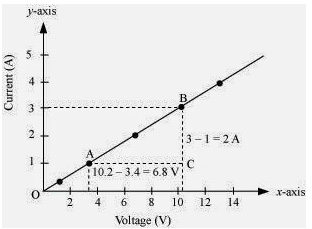
The slope of the line gives the value of resistance (R) —
Slope = 1/R = BC/AC = 2/6.8
⇒ R = 6.8/2 = 3.4 Ω
Question 8: When a 12 V battery is connected across an unknown resistor, there is a current of 2.5 mA in the circuit. Find the value of the resistance of the resistor.
Answer: According to Ohm’s law —
V = IR
Or, R = V/I
Substituting the values —
R = 12/0.0025 = 4.8 × 103 Ω
Question 9: A battery of 9 V is connected in series with resistors of 0.2 Ω, 0.3 Ω, 0.4 Ω , 0.5 Ω and 12 Ω, respectively. How much current would flow through the 12 Ω resistor?
Answer: Total resistance, R = 0.2 + 0.3 + 0.4 + 0.5 + 12
Or, Total R = 13.4 Ω
Potential difference, V = 9 V
Current through the series circuit, I = V/R
Or, I = 12 / 13.4 = 0.67 A
There is no current division occurring in a series circuit. So, the current through the 12 Ω resistor will be same as 0.67 A.
Question 10: How many 176 Ω resistors (in parallel) are required to carry 5 A on a 220 V line?
Answer: Let’s consider the number of resistors required as ‘x’.
Then, the equivalent resistance of the parallel combination of resistor R is given by –
1/R = x × 1/176
R = 176/x
Now, using Ohm’s law. the number of resistors can be calculated as follows –
R = V/I
Substituting the values –
176/x = V/I
Or, x = (176 × 5)/220 = 4
Therefore, the number of resistors required is 4.
Question 11: Show how you would connect three resistors, each of resistance 6 Ω, so that the combination has a resistance of (i) 9 Ω, (ii) 4 Ω.
(i) 9 Ω
Answer: Consider the image below —
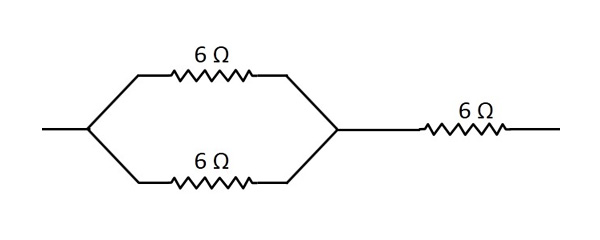
Two 6 Ω resistors are connected in parallel. Their equivalent resistance, R is given by
1/R = 1/6 + 1/6 = 2/6
Or, R = 6/2 = 3 Ω
The third 6 Ω resistor is connected in series with this equivalent 3 Ω. Hence, the equivalent resistance of the circuit is –
R = 6 Ω + 3 Ω = 9 Ω.
(ii) 4 Ω
Answer: Consider the image below —
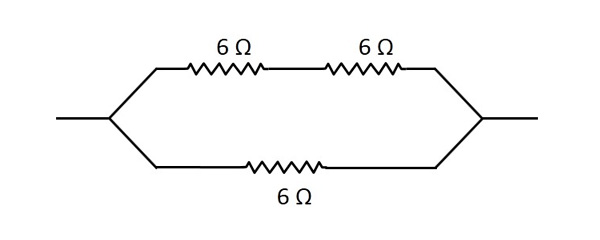
Two 6 Ω resistors are connected in series. Their equivalent resistance, R is given by
R = 6 + 6 = 12 Ω
The third 6 Ω resistor is connected in parallel with this equivalent 12 Ω. Hence, the equivalent resistance of the circuit is –
1/R = 1/12 + 1/6 = 3/12
Or, R = 12/3 = 4 Ω.
Question 12: Several electric bulbs designed to be used on a 220 V electric supply line, are rated 10 W. How many lamps can be connected in parallel with each other across the two wires of 220 V line if the maximum allowable current is 5 A?
Answer: Supply voltage, V = 220 V
Maximum allowable current, I = 5 A
Rating of electric bulb, P = 10 W
Now, the power P is given by P = V2/R
Or, R = V2/P
Hence, the resistance R of each bulb –
R = 2202/10 = 4840 Ω
The total resistance R‘ of x number of electric bulbs connected in parallel cab be achieved by –
1/R‘ = 1/R + 1/R + …….. x times.
Or, 1/R‘ = 1/R × x
Or, x = R/R‘ = 4840/R‘
Applying the relation, R = V/I
Total resistance R‘ = 220/5 = 44 Ω
So, x = 4840/44 = 110
Therefore, the total number of electric bulbs connected in parallel are 110.
Question 13: A hot plate of an electric oven connected to a 220 V line has two resistance coils A and B, each of 24 Ω resistance, which may be used separately, in series, or in parallel. What are the currents in the three cases?
Answer: Case 1: When the two coils A and B are used separately –
Resistance R = 24 Ω
So, the current I = V/R = 220/24
I = 9.17 A
Case 2: When the two coils are connected in series –
Equivalent resistance R = 24 Ω + 24 Ω = 48 Ω
So, the current I = V/R = 220/48
I = 4.58 A
Case 3: When the two coils are connected in parallel –
Equivalent resistance 1/R = 1/24 + 1/24 = 2/24
So, the current I = V/R = 220 × 2/24
I = 18.33 A
Question 14: Compare the power used in the 2 Ω resistor in each of the following circuits: (i) a 6 V battery in series with 1 Ω and 2 Ω resistors, and (ii) a 4 V battery in parallel with 12 Ω and 2 Ω resistors.
(i) a 6 V battery in series with 1 Ω and 2 Ω resistors
Answer: 1 Ω and 2 Ω resistors are connected in series. So, the equivalent resistance of the circuit, R = 1 + 2 = 3 ohm.
Now, applying Ohm’s law, V = IR
Or, I = V/R = 6/3 = 2 A
In series combination, the current in the circuit remains constant. Therefore, the power is given by –
P = I2R
Or, P = 22 × 2 = 8 W
(ii) a 4 V battery in parallel with 12 Ω and 2 Ω resistors
Answer: 1 Ω and 2 Ω resistors are connected in parallel.
Again, I = V/R = 6/3 = 2 A
In parallel combination, the voltage in the circuit remains constant. Therefore, the power is given by –
P = V2/R = 42/2 = 8 W
End of Page no 193 solutions – Chapter 11 Exercise 8 – Chapter end exercise. NCERT Solutions for Class 10 Science Chapter 11.
Page 194
Chapter End Questions – Page 194 Solutions
Question 15: Two lamps, one rated 100 W at 220 V, and the other 60 W at 220 V, are connected in parallel to electric mains supply. What current is drawn from the line if the supply voltage is 220 V?
Answer: Since both the bulbs are connected in parallel, the voltage across each of them will be the same.
Now, the Current drawn by the bulb of rating 100 W is given by –
Power, P = V I
Or, I = P/V = 100/220 A
Also, current drawn by the bulb of rating 60 W is given by –
I = P/V = 60/220
So, the total current drawn from the line = 100/220 + 60/220 = 0.727 A
Question 16: Which uses more energy, a 250 W TV set in 1 hr, or a 1200 W toaster in 10 minutes?
Answer: The energy consumed by an electrical appliances is given by the equation —
H = P × t, where P is the power of the appliance and t is the time.
Now, energy used by 250 W TV set in 1 hour = 250 W × 1 h = 250 Wh
And, energy used by 1200 W toaster in 10 minutes = 1200 × 10/60 = 200 Wh
Comparing the results, we can easily tell that the TV set uses more energy than the toaster.
Question 17: An electric heater of resistance 8 Ω draws 15 A from the service mains 2 hours. Calculate the rate at which heat is developed in the heater.
Answer: R = 8 Ω,
I = 15 A,
t = 2 h
Now, the rate at which heat is developed in the heater is equal to the power –
P = I2 × R = (15)2 × 8 = 1800 J/s
Question 18: Explain the following.
(a) Why is the tungsten used almost exclusively for filament of electric lamps?
Answer: Tungsten has a very high melting point and resistivity. Due to these two properties tungsten can produce and maintain high temperatures.
(b) Why are the conductors of electric heating devices, such as bread-toasters and electric irons, made of an alloy rather than a pure metal?
Answer: Alloys have higher melting points than a pure metal. They also are preferred in heating devices because of the heat they produce. This is because of their reduced conductivity which also prevents an electric shock since metals are good conductors while alloys are not.
(c) Why is the series arrangement not used for domestic circuits?
Answer: In series arrangement, failure of one component results in failure of the complete circuit. Also, each device will get different voltages in series arrangement. Therefore, parallel connection is preferred over series connection.
(d) How does the resistance of a wire vary with its area of cross-section?
Answer: Resistance (R) of a wire is inversely proportional to its area of cross-section (A). It can be written as R ∝ 1/A. Thus, increasing the area of cross-section of wire (thickness of wire) decreases its resistance. Or, when the area of cross-section of wire decreases, then its resistance increases.
(e) Why are copper and aluminium wires usually employed for electricity transmission?
Answer: Copper and aluminium wires are good conductors of electricity because of their low resistivity. Thus, they are usually employed for transmission of electricity.
End of Page no 194 solutions – Ch 11 Ex 8 – Chapter end question answer. NCERT Solutions for Class 10 Science Chapter 11.

